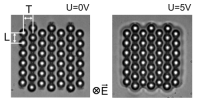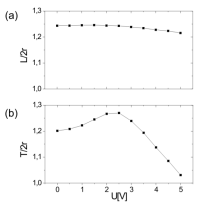Effects of electric field on 2D crystalline structures in nematic colloids

2D dipolar colloidal crystal
(a) at U = 0 and (b) at U = 5V.

Longitudinal strain and transverse strain
normalized to the colloidal diameter
as a function of external voltage.
2D nematic colloidal crystals are interesting for application in field-controlled Bragg diffraction gratings. We have shown that diffraction of visible light from 2D dipolar nematic colloidal crystals can be tuned electrically. When the external electric field of 1V/um is applied in a direction perpendicular to the plane of the 2D colloidal crystal, the induced strain in the liquid crystal is highly anisotropic, and the inter-colloidal spacing changes for as much as 20% along one direction and 2% along the perpendicular one. In the transverse direction, the response is non-monotonic with increasing electric field and is the result of two competing mechanisms: below the Freedericksz transition the field pushes the chains of colloidal particles apart, whereas above the Freedericksz transition, the surrounding liquid crystal tends to compress the colloidal structure. The time of the response is of the order of ten seconds and is an intrinsic property, resulting from the flow of the liquid crystal during the restructuring of the crystal.
This this novel tuning mechanism could be interesting for photonic applications, where the time response is not critical, but the range of change of crystal spacing should be as large as several tens of percents.
1.
M. Humar, M. Škarabot1, M. Ravnik, S. Žumer, I. Poberaj, D. Babič and I. Muševič,
Electrically Tunable Diffraction of Light from 2D Nematic
Colloidal Crystals, Eur. Phys. J. E 27, 73-79 (2008).




